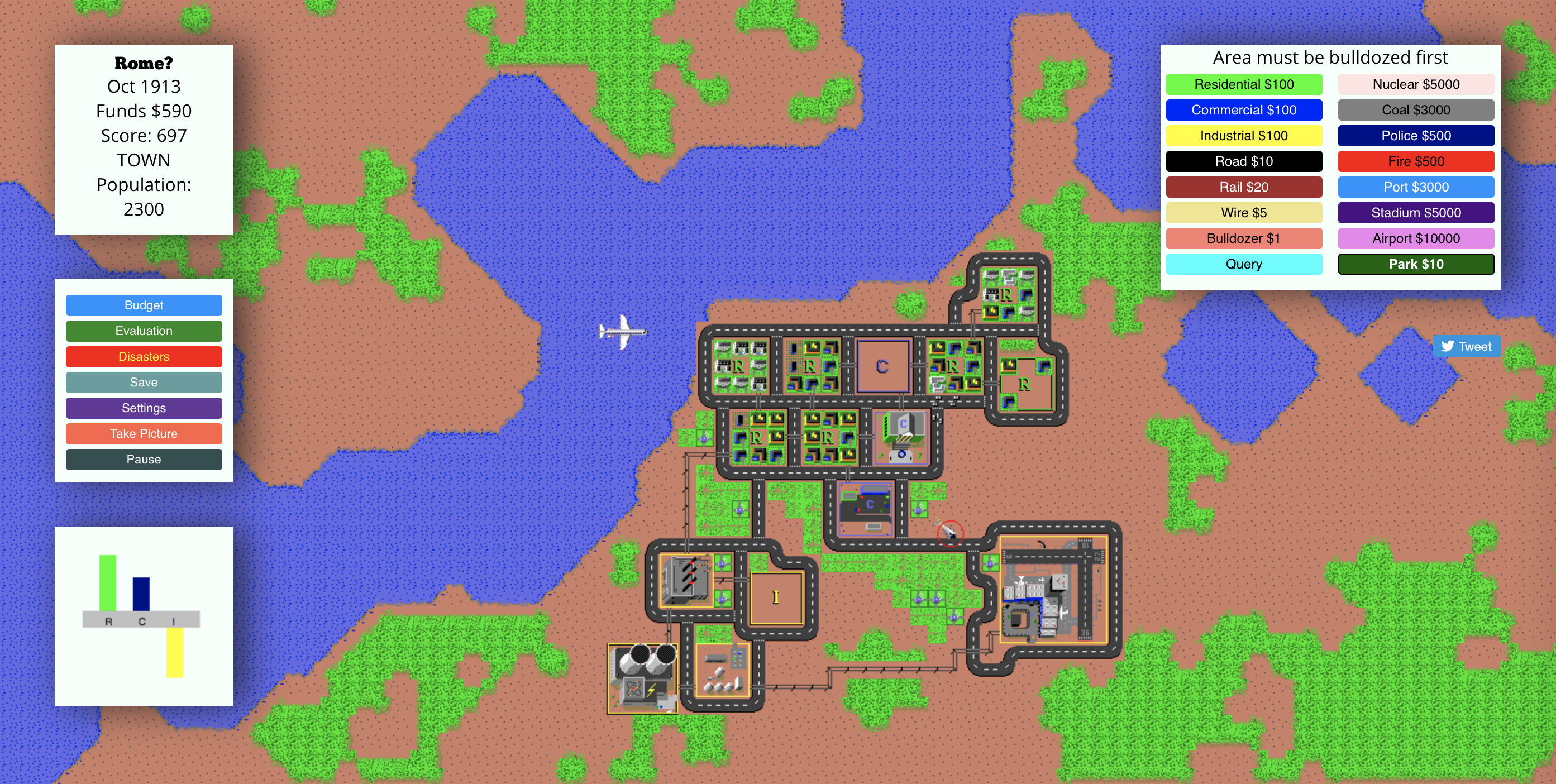The challenge of adapting the open-source SimCity port, Micropolis, to a historic setting is that it’s a semi-realist game taking place in a generic modern setting; its purpose as a game is to model the behaviours and construction patterns of present day cities. My current work has been focused on playing the game, and through this conceptualizing the “surface level” mechanics into variants plausible for ancient Rome during its time as an empire. I felt like focusing on all of ancient Rome— and by that I mean the kingdom, republic, and empire stretching from 753BC to 476AD— would be too inconsistent and expansive for a game meant to be simplistic and educational. If I wanted to be inclusive, I think there would have to be a new verions of this modified game for each period! For myself and the current modification, I came up with an easy goal to build from (despite all the questions that ended up coming with it): the game’s purpose and concept is to emulate ancient Rome and create variant or ‘version’ of an ancient Roman city in its empire. From here began my breakdown of the ‘basics’.
Maps
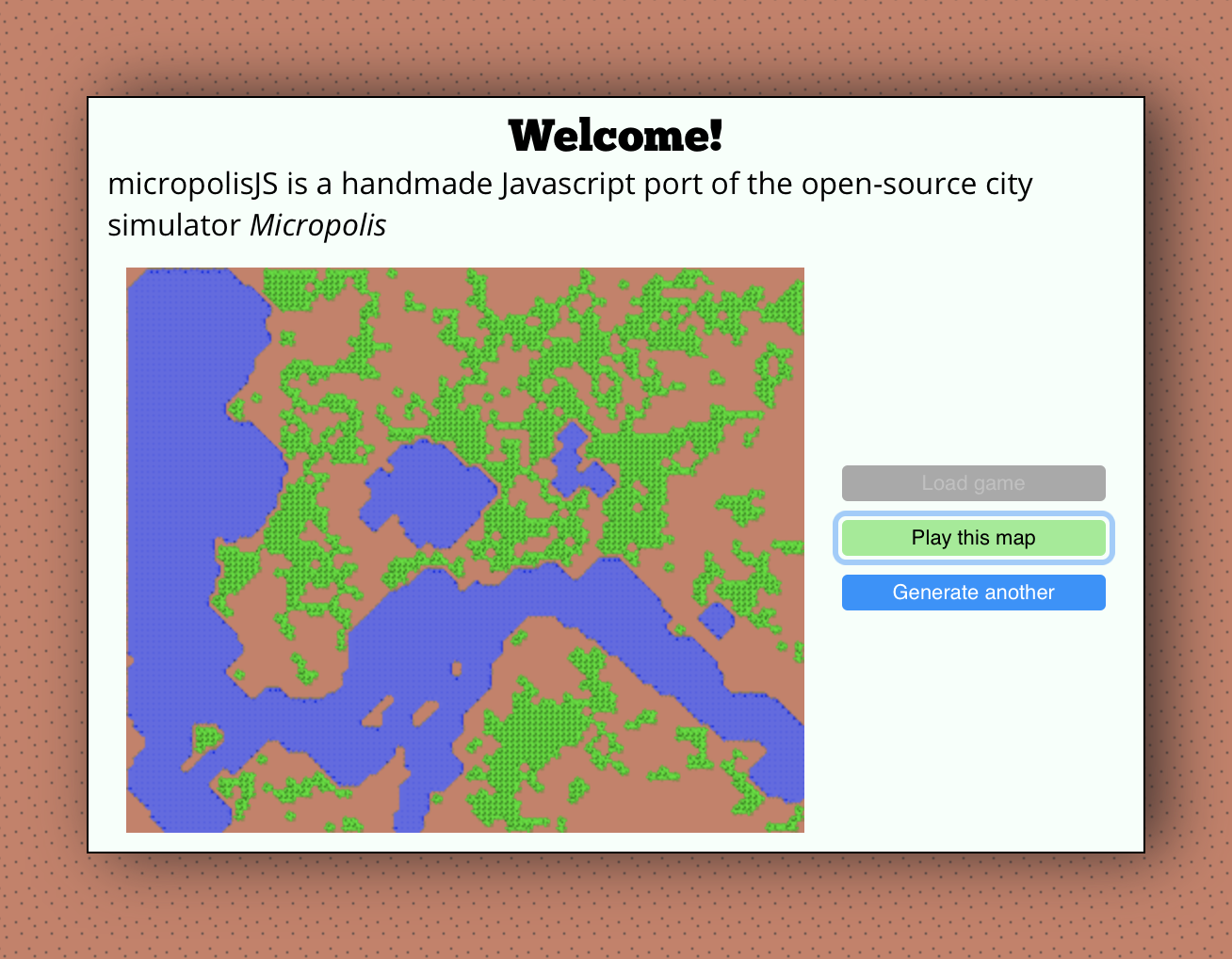
Maps are the first thing a player is presented with when playing Micropolis. They are randomly generated and once a player selects one, they are told to name it then placed in-game where they now are able to begin the construction of their city. The randomly generated maps outputted currently by the game are actually generally accurate and good for a player who is attempting to create a Rome-like city. Upon generating 50 maps, only 7 of them weren’t suitable for the purpose of creating a Roman city, because they were islands. This issue could easily be fixed by putting a restriction on the randomization process of creating the maps, making it so only waterside or inland maps can be generated for the user. Beyond the geography, the game seems to depict a warm weather climate that doesn’t go through seasonal changes, which is correct for the location as Rome was said to have hot summers and rainy but mild winters. *Micropolis*’s overall provided Mediterranean climate produced through the maps is a near-perfect base for a ‘Rome’ to start.
Info Box
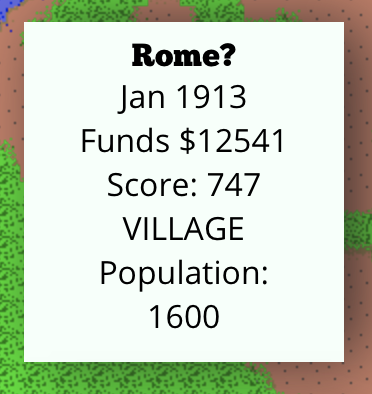
Once a player gets pasts the map selection options and enters gameplay mode, they are immediately given a variety of utilities, some of which display data and others that are meant for the user to interact with. One of these utilities located in the upper left of the screen is a box that provides the basic information on a player’s city: the approximate date, funds available, performance score, and population. For the purpose of this post, I’ll call this the “Info Box”. In the Info Box, there are two modifications I would make, with the first being an issue which I’m still unsure of and thinking over the ideal solution. The year that Micropolis automatically starts in is 1900, so in modifying the game to build a Rome-like city within the Roman empire, this would obviously have to be altered. Setting the game to begin in 753BC and progress accordingly is simple, but Micropolis– after beginning in 1900– progresses infinitely and goes as long as the user continues to play. As citizens of the year 2020, we know that the Roman Empire is finite, falling in 476AD. Letting the player go limitlessly would certainly result in an interesting game with the potential of growing their city in to modern, futuristic Rome, but ultimately this doesn’t hit the goal of an accurate (although it would be very exploratory) model of classical civilization. This gives to the solution that there must be some sort of ‘win’ case, with the game ending during the appropriate time setting. I thought of two solutions in relation to this concept, both requiring me to create a set of statistics and conditions that quantitatively measure the actual city of Rome during the Roman Empire:
When the end date arrives, the game ends, and whether the player ‘wins’ or ‘loses’ is based on how the player’s city’s stats measure up to the historical Rome’s stats. If they are equal or greater in all regards, this constitutes a ‘win’.
Building from the previous solution, but making it less competitive, instead of a win/lose case, the end just shows your stats in comparison to what would be the actual ‘stats’ of Rome in a graph or chart format. This would be the most educational based approach in my opinion.
Both solutions are similar in practice, but thinking them over makes me question the restriction of time, or the city having set end that the player HAS to go ‘til. What if a player– informed on the construction and ideal urban planning of Roman cities– reaches the stats of Rome or beyond, well before the set end? Should that be the ‘win’ case instead, or should the player be made to continue building their city to see if it falls as quickly as it was built? These are the questions I’m still deliberating over. Beyond the modification of time, a more decisive modification that should be done is on the indicator of available funds. I think it would be a fun addition to modify the display of wealth to be in denarii, the currency of the Roman Empire (Note: I am aware there were multiple forms of currency used in the Roman Empire besides denarii, but the denarius was the most common). This would truly only be a surface level change, as beyond converting the cost that were originally in USD to the denarius, tracking the worth of and modifying the denarius throughout the Roman Empire’s economic changes— while historically important— would be too complex of a game mechanic to add when it is not a central focus.
Options Menu
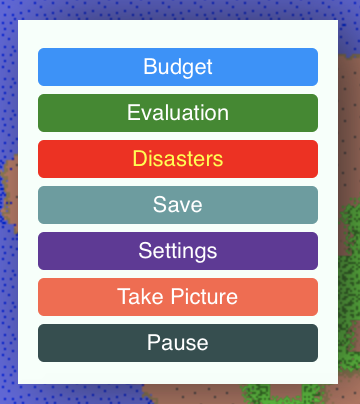
Located just below the Info Box is an ‘Options’ menu with a few choices a user can select. Most are relatively self explanatory (“Save”, “Settings”, “Pause”), or relatively simple and no changes need to be made. “Take Picture” takes a picture of either the map that is visible to the player or the full map. “Evaluation”, exemplified in the following picture, essentially provides a more in-depth Info Box.

The term “Mayor”, referring to the player, would be changed to ‘Emperor’, as during the Roman Empire it was the Emperor who held the ultimate power like the player does in Micropolis. Besides this, no further alteration would be needed and it would be this information combined with that from the Info Box that would be used as a template to create aforementioned stats on the actual, historical Rome for end-of-game comparison. From this Options menu, “Budget” and “Disasters” is where it gets interesting.

Revamping the “Budget” option is tricky business, for at no point was the Roman Empire a contemporarily defined capitalist society, like the one Micropolis is modelled after. The “Budget” options allows players to adjust where the citizen’s tax money is going, as well as giving to option to adjust the tax rate. The slider “Tax”, which adjusts the tax rate would evidently not have to be changed, because Roman citizens were taxed at varying rates through the existence of the Roman Empire. Beyond that, “Roads”, “Fire”, and “Police” are where the taxes are presently allowed to being allocated, yet the priorities of ancient Rome are different from modern day. So where did Romans prioritize their tax budget? Well, Rome was known for its grandeur and opulence, with a well constructed, planned out city, all of which was not a cheap achievement. For this reason, I would change “Roads” to a more general ‘Infrastructure’ that could contribute to the broader construction of the city. Besides infrastructure, a huge amount of tax money generated by the Roman Empire went towards funding their incredibly powerful military. In fact, during times of conflict, taxes were often raised or lowered depending on military needs. Taking this into consideration, I think military funding is a vital inclusion to the game, therefore I would replace “Police” with ‘Military’. “Fire” is the money that goes specifically towards firefighting, but I feel this would better be replaced by the term ‘Emergency Services’ so it can contribute towards both the police and firefighting following the replacement of the term “Police”. In the Roman Empire, both organizations were a smaller scale than they are in present day, so it is appropriate to have funding encompass both public services.
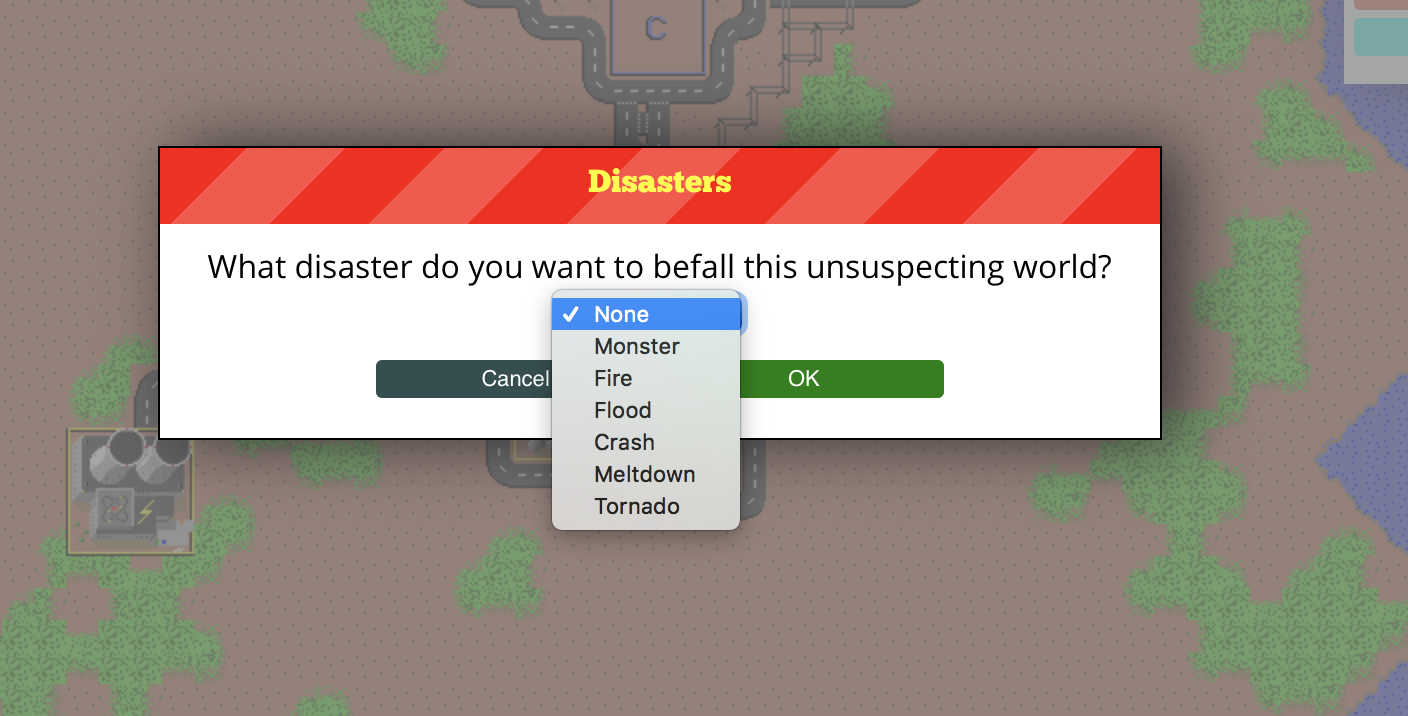
Now, I know I said earlier that I’m trying modify Micropolis to demonstrate accuracy so it can be used for exploratory city building, but the “Disasters” feature located in the Options menu is purposefully ‘fun’ and I intend to keep it that way (with modifications, of course). Selecting “Disasters” from the menu brings the play to another drop down menu that gives a variety of choices. A disaster is meant to cause randomized destruction to a player’s city, and following this allows the player to utilize their knowledge and resources to repair the damage thus presenting a creative way to rebuild. Disasters such as “Fire” and “Flood” are fine to leave as is; fires are common accidents and flooding is inevitable for riverine cities, Rome and surrounding cities being no exception with their proximity to the Tiber River. Even “Tornado” is fine as they do occasionally occur within the greater area of Rome, made evident to us by ancient Roman philosophers such as Seneca the Younger and Pliny the Elder theorizing their cause. But the other disasters? They could use some changes to make them more accurate to the Roman climate. In Micropolis, the disaster “Crash” implies a plane crash, which of course could not happen during the Roman Empire due to planes literally not existing nor being invented. I would like to replace this with ‘Invasion’, because like a crash, successful invasions are usually sudden and destructive, and tear up a portion of the city prior to being contained. The invaders would likely be depicted as a generic Barbarian tribe. The only issue this substitution presents is the fact that it is documented that the Barbarians plague Roman existence only in the later half of the Empire’s years. The work around for this could be an interesting feature to consider; I’d like to add a time lock to the ‘Invasion’ disaster making so it can only be accessed following, approximately, the year of 230AD. The disaster “Meltdown” presently signifies a nuclear meltdown, which sets a player’s city on fire and riddles the area with nuclear waste. Of course there can’t be a nuclear meltdown in ancient Roman, but this is the perfect opportunity to pay homage to the eruption of Mount Vesuvius in 79AD that destroyed the Roman city of Pompeii. In a modification, “Meltdown” would be replaced with ‘Eruption’. ‘Eruption’ would begin with short earthquakes, then build up to a pyroclastic surge of toxic gases and pyroclasts, which would replace the role of nuclear waste and cause an initial decline of population. Finally, to cause the fires, hot ash and volcanic rock would rain down upon the player’s city causing the geographic and physical damage. Lastly, ancient Rome is home to a wealth of mythology, so I feel it would be shame to simply leave the disaster “Monster”, as an unspecified creature. In Micropolis, when this disaster is evoked a monster emerges and destroys areas of the player’s city at random, turning it to rubble. I would replace this “Monster” with ‘Cacus’— Cacus being the fire-breathing giant from Roman myth. In myth, Cacus was man eating— as many classical giants were— and terrorized the villages surrounding his cave, crumbling homes to obtain new meals. His cave was also said to be located where the city of Rome was later founded, so I think its fitting for him to be a Roman city dwelling/destroying monster, occasionally unleashed. Not as an alternative but as an additional, uncontrolled factor to add an extra element of challenge to the game, I would also like to add burial grounds that result from disasters. In the current Micropolis, I’m guessing burial either isn’t taken into consideration with such simplistic gameplay or supposed to be assumed that it occurs within the city. During the time of the Roman Empire, burial of the dead always was done outside of city limits. Thought to have derived from disease prevention practices, Roman dead were buried in either designated burial grounds or private burial spots that lined roads leading to Rome. I would like to make it so that every time a player calls for a disaster, and 150 or more citizens die as a result, a burial ground occupying four tiles is added. Areas in the city that are near a burial ground lower in value, for example, an area that was previously middle class would move to lower class. Additionally, space occupied by the burial grounds could not be built over as desecrating sacred places was a high crime in the Roman Empire, so they would limit where important outer-city zones such as industrial districts, power plants, and roads could be placed in the future, mildly inconveniencing the player.
Tools

The “Tools” panel is located in the upper right corner of Micropolis once in gameplay, and is the most essential component to the game because it is what allows the player to actually build. Each option is a button, with the name of what can be built and the cost associated listed. Reading the options and looking at the visual they produce, I have categorized most items as either needing ‘redecorating’ or replacing. Beginning with the ‘redecoration’, the roads currently depicted when placed on the map are the stereotypical tarmac roads of modern day. I would alter this imagery by removing the yellow lines and making the road a light white-brown colour, with a darker brown coloured border to emulate Roman public roads, or viae publicae. These roads were built using multiple layers of stone, rough gravel, and clay materials to aide in drainage, with the top layer being a finer gravel occasionally mixed with limestone, or larger stones placed in a cobbled pattern, for smoother travel. The darker brown along the edges of the road would represent the the road’s slope into the ditches that were dug for drainage. On the similar topic regarding the aesthetics of infrastructure, the images representing the “Residential”, “Commercial”, and “Industrial”, need to be replaced as, again, they represent modern living and commodities. The residential areas’ housing art could simply be replaced with squares varying between a white or clay colour, to showcase both the grand homes of plaster and marble, alongside the more humble dwellings of mud brick and wood. Both would have a brown spot in the centre, signifying a courtyard for insulae (lower class housing) or an atrium for domus (middle-upper class housing). The commercial districts would appear as a forum, the historical Roman marketplace. The centre of the square would be a paved rectangle, and along the perimeter, market stalls would appear alongside opulent white government offices and banks. In terms of “Industrial”, in Micropolis, industrial areas appear outside of the city as factories, so the imagery currently shown should be replaced by Roman industries where production did not occur from within the city. I would replace them with wheat farms and mines, as milling grain was apart of daily business and cooking within the Empire, and mining iron, copper, tin, lead or gold was constant because it was needed for the production of weapons and common items such as jewelry or tools. Looking at “Tools” that need to be replaced, there is many, the most significant being the ways of transportation and energy. “Stadium”, with alteration to the image it generates, can easily be replaced by ‘Colosseum’, and “Park” can be instead called “Garden”– no problems there. Beyond that, I feel the options of “Coal” and “Nuclear” energy generation are the second most obvious in what they could be replaced by. While not intended for the production of energy, fuelling the Roman Republic and later Empire were the aqueducts, one of the greatest innovations of classical civilization. The options of “Coal” and “Nuclear” would merge into a single option of “Water Source”, which would generate at random a springhouse or reservoir, and the “Wire” tool that is traditionally used to connect the power plants to the residential/commercial/industrial districts, will now be ‘Aqueduct’, which will connect the water source to the districts. Then comes the issues of “Rail” and “Airport”. I’m no expert, but I’m confident in saying that there were neither trains nor planes during the Roman Empire. Those who travelled by road via chariot or carriage were the closest thing Rome had to “Rail”, and both modes of transportation were somewhat of a luxury as chariots were expensive and the horses pulling them had to be maintained. Due to this extra cost associated with travelling by road, many less wealthy Romans would follow alongside these roads and just walk to their destination. I’m thinking that, with this in mind, “Rail” should be replaced with “Footpath” allowing more common citizens the ability to move beyond the central city. With the notion of transport as a central idea, I believe the closest thing “Airport” could be substituted with is an ‘Inn’, which like an airport acts a central hub for travellers as point of arrival and departure, with the ability to ‘refuel’ their means of transportation whether that be by feeding their horses, eating, or resting. Now, in terms of “Police” and “Fire”, which respectively construct a police and fire station, I will replace with there respective Roman counterparts. The visuals of their ‘base’ would be that of a traditional government structure with symbols on the roofs to reveal the building as either a police base (a sword) or firefighting (a flame). “Police” would be instead dubbed ‘Urbanae’, short for cohortes urbanae. The cohortes urbanae were a kind of police force in the Roman Empire, whose primary task was to act against street-roaming gangs and maintain civil order. They would also perform riot control during tumultuous times, and often aided in the arrest of violent criminals. Replacing “Fire” would be ‘Vigiles’, short for vigiles urbani, watchmen of the city. The vigiles patrolled streets nightly for unsupervised fires, and from this you can guess that they were also in charge of putting out fires. They were as equip as an ancient firefighter could be, having their own pumps, bucket, and axes amongst other things for extinguishing fires and rescuing citizens from the flames.
So there you have it: my extensive plans to reconstruct Micropolis into an educational city-building game. This post is long, and yet I still feel I haven’t touched every aspect of the game that I’ll end up modifying. All these modifications are very surface level, but I want to go more in-depth, studying the game mechanisms themselves and seeing how they may conflate with Roman urban planning and infrastructure. Though the most important next step for this hands-on element of my research is actually setting up a workflow and figuring out how to get the source code to actually compile on my computer! I can modify all I want (and honestly, I’ve already started commenting through areas that need to be changed), but programs that don’t compile are useless programs! Once I can get past that major hurdle, I can test what works from here and what doesn’t. For now, I’ll be holed up trying to fix the 70+ errors being thrown at me.
